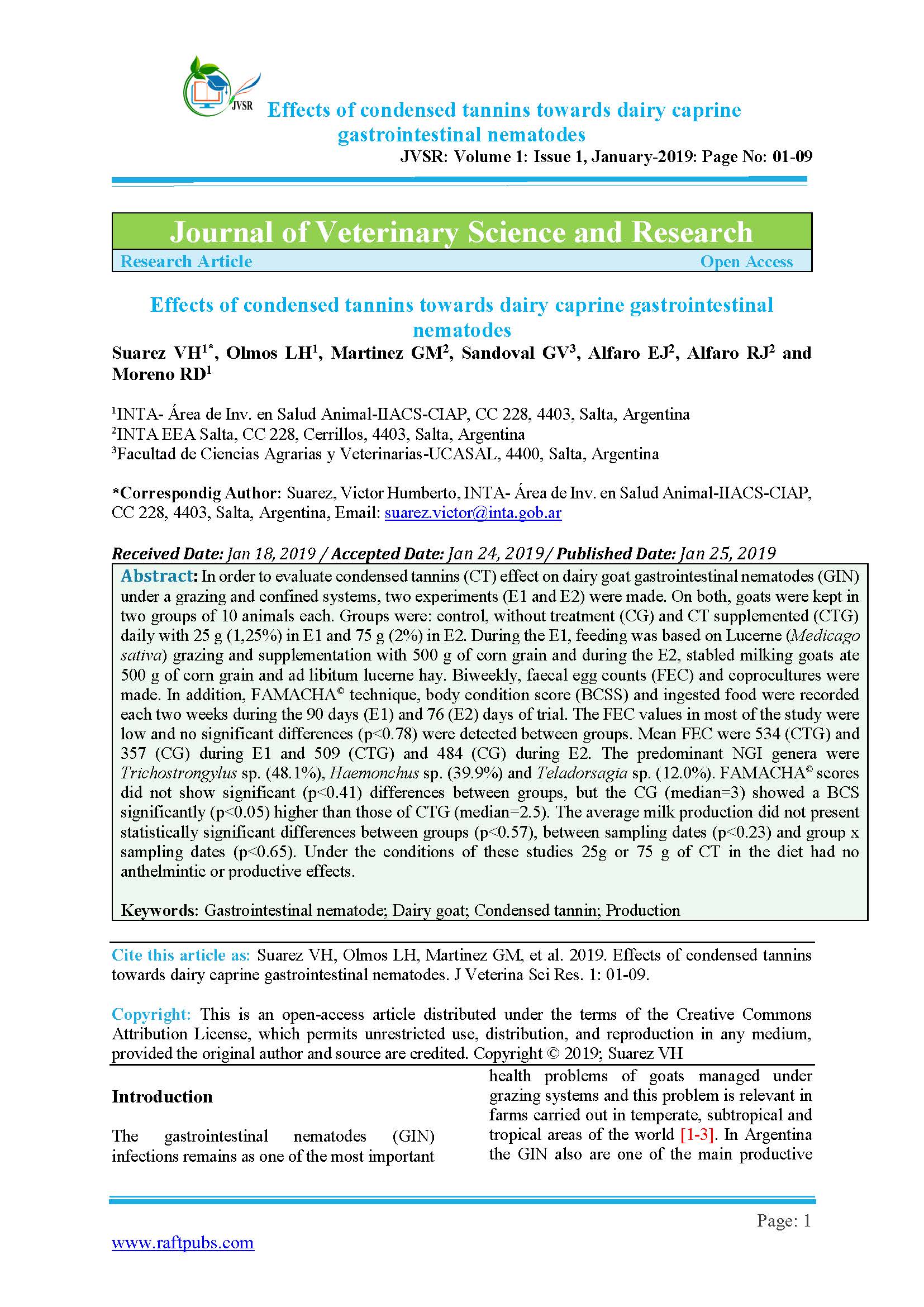Ver ítem
- xmlui.general.dspace_homeCentros e Institutos de InvestigaciónCIAP. Centro de Investigaciones AgropecuariasInstituto de Investigación Animal del Chaco SemiáridoArtículos científicosxmlui.ArtifactBrowser.ItemViewer.trail
- Inicio
- Centros e Institutos de Investigación
- CIAP. Centro de Investigaciones Agropecuarias
- Instituto de Investigación Animal del Chaco Semiárido
- Artículos científicos
- Ver ítem
Effects of condensed tannins towards dairy caprine gastrointestinal nematodes
Resumen
In order to evaluate condensed tannins (CT) effect on dairy goat gastrointestinal nematodes (GIN) under a grazing and confined systems, two experiments (E1 and E2) were made. On both, goats were kept in two groups of 10 animals each. Groups were: control, without treatment (CG) and CT supplemented (CTG) daily with 25 g (1,25%) in E1 and 75 g (2%) in E2. During the E1, feeding was based on Lucerne (Medicago sativa) grazing and supplementation with 500 g of
[ver mas...]
In order to evaluate condensed tannins (CT) effect on dairy goat gastrointestinal nematodes (GIN) under a grazing and confined systems, two experiments (E1 and E2) were made. On both, goats were kept in two groups of 10 animals each. Groups were: control, without treatment (CG) and CT supplemented (CTG) daily with 25 g (1,25%) in E1 and 75 g (2%) in E2. During the E1, feeding was based on Lucerne (Medicago sativa) grazing and supplementation with 500 g of corn grain and during the E2, stabled milking goats ate 500 g of corn grain and ad libitum lucerne hay. Biweekly, faecal egg counts (FEC) and coprocultures were made. In addition, FAMACHA© technique, body condition score (BCSS) and ingested food were recorded each two weeks during the 90 days (E1) and 76 (E2) days of trial. The FEC values in most of the study were low and no significant differences (p<0.78) were detected between groups. Mean FEC were 534 (CTG) and 357 (CG) during E1 and 509 (CTG) and 484 (CG) during E2. The predominant NGI genera were Trichostrongylussp. (48.1%), Haemonchus sp. (39.9%) and Teladorsagia sp. (12.0%). FAMACHA© scores did not show significant (p<0.41) differences between groups, but the CG (median=3) showed a BCS significantly (p<0.05) higher than those of CTG (median=2.5). The average milk production did not present statistically significant differences between groups (p<0.57), between sampling dates (p<0.23) and group x sampling dates (p<0.65). Under the conditions of these studies 25g or 75 g of CT in the diet had no anthelmintic or productive effects.
[Cerrar]

Autor
Fuente
Journal of Veterinary Science and Research 1 (1) : 1-9 (January 2019)
Fecha
2019-01-25
Editorial
RAFT Publications
Formato
pdf
Tipo de documento
artículo
Palabras Claves
Derechos de acceso
Abierto
 Excepto donde se diga explicitamente, este item se publica bajo la siguiente descripción: Creative Commons Attribution-NonCommercial-ShareAlike 2.5 Unported (CC BY-NC-SA 2.5)
Excepto donde se diga explicitamente, este item se publica bajo la siguiente descripción: Creative Commons Attribution-NonCommercial-ShareAlike 2.5 Unported (CC BY-NC-SA 2.5)


